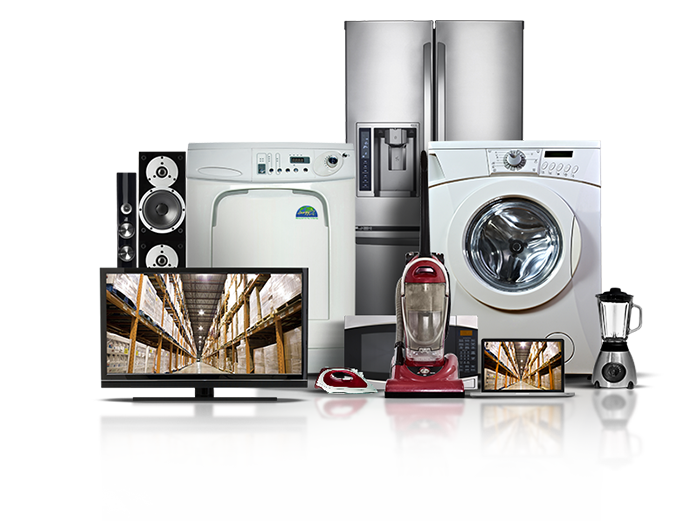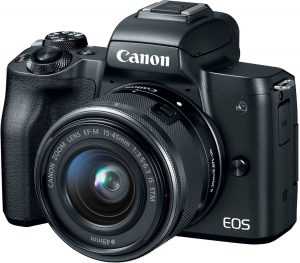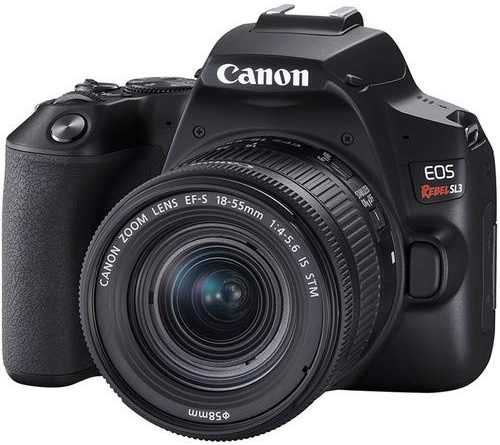Canon EOS Rebel sl2: full review
Canon EOS Rebel sl2 can be defined as “entry level advanced”, meaning a camera designed for people approaching a reflex, with almost professional ambitions, for the first time.
Canon EOS Rebel sl2 is a good quality all-rounder: it offers good quality images, next-generation connections, better video performance than the competition and an affordable price for the quality offered (around 600 euros for the camera body).
From a strictly technical point of view, this Rebel camera is not excellent but is good at everything. This might seem a flaw, but it’s not when you don’t have any particular need and you want to try your first reflex, with results not far from professional cameras.
If I had to point out two strengths, I would definitely say the solidity of the camera body and the excellent performance of the LCD display.
Дизайн и удобство
В природе встречается три расцветки корпуса: черная, серебристая и белая. Я выцепил именно последний вариант. Как по мне, он самый оригинальный. Уже тошнит от бесконечного засилья этих чёрных, едва отличимых друг от друга брусков. Да и на травке белая тушка смотрится ого-го! Смотрите сами.

Да-да, сейчас матёрые фотографы с бородами и фоторюкзаками на 50 литров закидают меня помидорами, мол нормальный инструмент должен быть только чёрного цвета. Но я скажу вам, ребята, что пора уже сдуть пыль со своих стереотипов на сей счёт. Ну, а Canon надо срочно выпустить красную модель Product RED. Вот это будет бомба!



Корпус у нас выполнен из алюминиевого сплава и поликарбонатной смолы в замесе со стекловолокном. О чём это нам говорит? А о том, что фотоаппарат очень лёгкий.
Даже со штатным объективом EF-S 18-55 IS вес аппарата минимальный — до 700 г.
Однако алюминиевый сплав я не нащупал. Видимо, он где-то внутри корпуса, задействован в качестве рамы, а снаружи у нас, грубо говоря, только пластик. Это производит, конечно, не очень положительное впечатление. Солидностью, премиальностью тут и не пахнет. Зато аппарат лёгкий и поверьте, в походах это, пожалуй, даже важнее. Особенно когда у тебя в рюкзаке лежит ноутбук, пара зарядок, павэрбанк, планшет, смартфон и всё в таком духе. Через два-три часа такая сумка становится настоящей обузой. Кстати, владельцы марков разных поколений, как вы там, ребята?

Наконец-то поворотный дисплей стали устанавливать во все новые фотоаппараты.
Теперь эта функция не позиционируется, как некое невиданное чудо. Теперь это в порядке вещей. Правда, чёрный экран с большими тёмными рамками на белом корпусе смотрится… оригинально. Это как минимум.



Вторая обязательная фишка в любом современном фотоаппарате — это сенсорный экран.
Фокусироваться на нужном участке кадра можно просто тыкая пальчиком по дисплею. Удобно? Ещё как! Таким же образом выбираем настройки съёмки, лазаем по меню, пролистываем изображения и даже увеличиваем их привычным щипком двумя пальцами. Кра-со-та!

Сам по себе экран отличного качества. У него есть не самое лучшее, но всё-таки не плохое олеофобное покрытие, он контрастный, яркий, на солнце остаётся читаемым. Дисплей из той категории, на котором всё смотрится отлично, а когда скидываешь фотоматериалы на компьютер — волосы встают дыбом.
Кстати, 200D может похвастаться встроенным акселерометром. Он мгновенно переворачивает изображение, если фотограф вдруг решил поснимать вертикально. Вроде бы мелочь, но о ней не забыли.

По управлению и прочим вещам — всё более-менее стандартно для устройств Canon. Стандартно, но кнопочек, конечно, маловато. Например, экспозицию ты крутишь пластиковым кольцом-переключателем, а для настройки диафрагмы приходится зажимать ещё и клавишу AV. Для бывалых «сапоговодов» это норма, а для новых пользователей такой поворот событий может поначалу вгонять в ступор. Нужно приноравливаться.

Как и у любой камеры начального уровня, у Canon 200D есть встроенная вспышка. Она достаточно мощная, поэтому для простецких съёмок в помещении её хватит с головой. Нужен более серьёзный инструмент? Для этого на верхней части корпуса есть горячий башмак для подключения внешней «пыхи».

Без вспышки

Со вспышкой
Ещё немного пробежимся по корпусу и перейдём к самому интересному.
Внешний динамик тут один, находится слева от видоискателя. По громкости он не плохой, а вот по качеству мог бы быть и лучше — на максимальной громкости похрипывает.


Из разъёмов присутствуют: 3,5 мм выход для подключения микрофона, 2,5 мм для пульта управления, mini USB (и это во времена USB Type-C) и Mini HDMI.


Build Quality and Handling
Since the rise of mirrorless technology, “small” and “light” have taken on new meanings – but the SL2 and SL3 genuinely are lightweight, compact cameras, clocking in at 453 g/15.98 oz and 449 g/15.84 oz, respectively. They also feature identical 122x93x70 mm/4.8×3.66×2.76 in dimensions.
Honestly, while the SL2 is technically heavier than the SL3, I’d be astonished if you could tell the difference. Both models are supremely travel-ready, and you can comfortably carry them in a backpack, in a purse, or around your neck without ever breaking a sweat. The builds aren’t bad, either; while neither camera is weatherproof and both are made of plastic, you’ll never feel like you’re carrying junk.
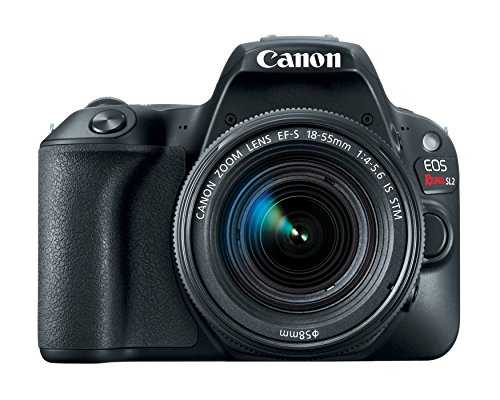
Canon EOS Rebel SL2 with 18-55mm Digital SLR Camera Kit 2249C002 (Renewed) (Image from Amazon)
In other words, both models are perfect for frequent travelers, hikers, and bikers, as well as anyone who simply wants a camera they can carry with them to events, both indoors and out.
In terms of ergonomics, both models feel great, and while they’re certainly smaller than their DSLR competitors, the front grips are meaty enough that you shouldn’t run into any problems.
Both models also offer fully articulating touchscreens. This is one of the areas where Canon consistently beats Nikon and the reason why the SL2 and SL3 work well for vlogging. The ability to flip the screen and see yourself while recording is a huge deal, and you’ll also appreciate the articulating LCDs if you like to shoot macro or architecture, where the need to get low will often cause a stiff neck.
As for the ergonomic differences: While the SL2 and the SL3 are practically indistinguishable, the SL3 loses the depth of field preview button. (This lets you view the depth of field before taking a shot. Honestly, I’ve been doing photography for over a dozen years, and I can count the number of times I’ve used the DOF preview button on one hand.)
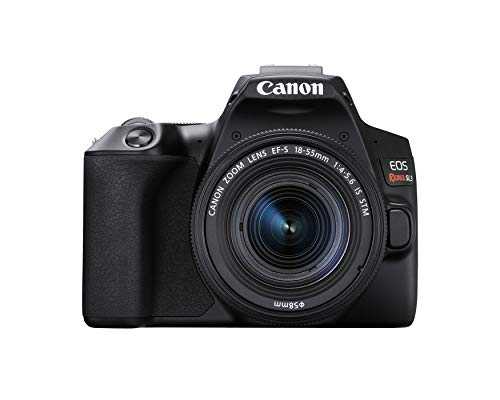
Canon EOS Rebel SL3 Digital SLR Camera with EF-S 18-55mm Lens kit, Built-in Wi-Fi, Dual Pixel CMOS AF and 3.0 Inch Vari-Angle Touch Screen, Black (Image from Amazon)
That’s about it for the differences. Both cameras offer a single SD card slot, 1040K-resolution LCD screens, and wireless capabilities for transferring images on the fly. In other words, when it comes to build and handling, it’s essentially a tie.
Conclusions
The SL2 is a solid option for any entry-level user in search of an SLR, but it’s by no means bleeding edge in terms of performance. It’s not the absolute best at anything it does, but it does a lot of things well. Image quality is much better than what you get with the Rebel T6, even though it lags slightly behind competing cameras from Nikon and Sony at higher ISO settings, which it will use in dim light. Its video isn’t 4K, but it focuses smoothly when recording in 1080p, a feature usually reserved for mirrorless cameras.
If you’re looking for a camera to capture family memories that you can carry easily when traveling, the SL2’s size makes it quite appealing. I tend to recommend mirrorless models more highly, but if you feel more comfortable with an optical viewfinder or already own a few Canon EF or EF-S SLR lenses, the SL2 makes sense. The guided interface is also a plus for folks who want to take a good picture, but aren’t expert photographers.
If you don’t mind a little extra bulk, and cost, the T7i ($749.00 at Amazon) is our Editors’ Choice SLR. It has the same image sensor and guided interface option, but its autofocus system is much more capable, so it’ll do a better job keeping up with speedy subjects.
Canon EOS Rebel SL2
3.5
Check Stock
$899.00 at Amazon
MSRP $549.99
Pros
- Really small and light.
- 24MP APS-C image sensor.
- Dual Pixel AF in Live View.
- Vari-angle touch LCD.
- Microphone input.
- Guided user interface.
- Wi-Fi.
View More
Cons
- Dated nine-point focus system.
- Some focus lag in live view.
- Small Raw shooting buffer.
- Video limited to 1080p.
View More
The Bottom Line
The Canon EOS Rebel SL2 is the smallest SLR camera in the company’s lineup. It boasts a modern 24MP image sensor, but its autofocus system isn’t as good as the larger T7i.
Like What You’re Reading?
Sign up for Lab Report to get the latest reviews and top product advice delivered right to your inbox.
This newsletter may contain advertising, deals, or affiliate links. Subscribing to a newsletter indicates your consent to our Terms of Use and Privacy Policy. You may unsubscribe from the newsletters at any time.
Thanks for signing up!
Your subscription has been confirmed. Keep an eye on your inbox!
Sign up for other newsletters
Image Quality
The lens I used was the Canon EF-S18-55mm F/4-5.6 IS STM, which has a 35mm-equivalent focal range of around 29-88mm. Most of the test photographs were taken using the Standard Picture Style and the Shutter- or Aperture-priority exposure modes, respectively.
The image quality was pretty decent compared to other cameras in this price range. All of the colors are richly saturated and appear to be natural in appearance.
Canon’s Auto white balance maintains the warm hues produced by, for example, tungsten light. Therefore, the Auto WB on the SL2 may be changed to either Ambience priority or White priority, much like it can be on other recent Canon cameras. Under tungsten lighting, the former produces warmer photos (similar to sepia-toned). The latter compensates for the light and balances the colors to generate more realistic whites by balancing the colors.
Предистория
Как коммерческий фотограф, я использую цифровые камеры EOS, в основном серии 1D, уже более 10 лет. В моем арсенале 14 объективов, включая пять светосильных L-объективов и три Цейсса. Можно однозначно сказать, что основные инструменты я выбрал много лет назад, объективы меняю редко, а камеры — регулярно. Во времена плёнки я в поездки брал с собой Лейку Minilux. Года два назад я искал для путешествий цифровую камеру размером поменьше, но с сенсором реальных размеров — идея сенсора «с ноготок» меня никогда не согревала. Я перебрал все имевшиеся на рынке компактные камеры со сменной оптикой, и в конце выбрал EOS 550D. С такой камерой я ездил во все поездки последних лет.
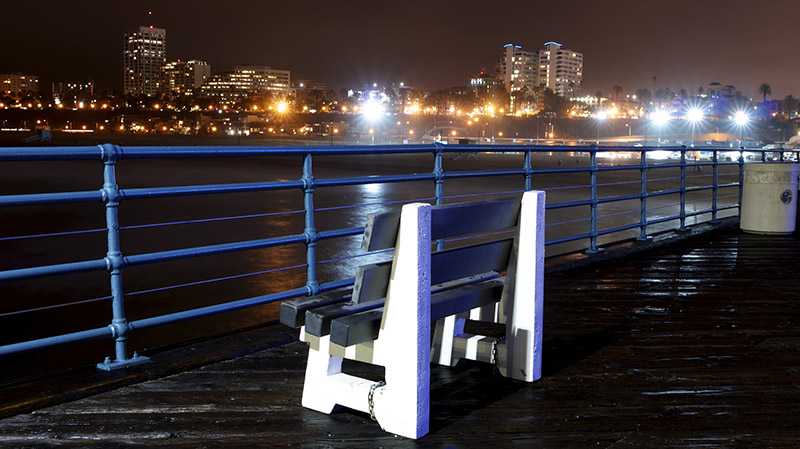 Canon EOS DIGITAL REBEL XSi, Zeiss Distagon 21/2,8, ISO 100, f/9, 30 с.
Canon EOS DIGITAL REBEL XSi, Zeiss Distagon 21/2,8, ISO 100, f/9, 30 с.
Но тоска по эквиваленту Minilux осталась — хотелось найти компактную камеру с премиальным качеством. Поэтому я с удовольствием согласился протестировать кит EOS M + EF18-55.
Я задал себе ряд вопросов и попробовал ответить на них с помощью этой камеры. Если вас интересует логика моих ответов, просмотрите все главы (предупреждаю: много фото). Если вам важны только конечные выводы — переходите прямо к заключению.
Taking picture with Canon EOS Rebel sl2
The experience with this camera is a natural passage from being a smartphone photographer to something more serious. Because this camera is slightly less easy to handle than a smartphone, but it offers so much more. The image quality, in the first place, and the shot control functions, that are prerogatives of digital reflex cameras (completely automatic, shutter priority, aperture priority and completely manual).
The automatic creative mode gives you the chance to modify some settings through the LCD display, acting as a tutorial to explain the basic element of photographic technique, such as aperture settings, exposure, shutters.
With the “Scene” mode, you tell the camera the kind of situation to photograph, with optimum parameters (preset by the camera). There is Portrait (also at night), Manual night shot, Food, Children, Candlelight, Macro, Group photo, Sport, HDR backlight control.
The creative filters are the best for social media lovers, especially Instagram: there are black-and-white, flou, fish-eye, tilt-shift, watercolor effect, miniature, and different HDR options (from the softest to the strongest).
Canon Rebel SL2 Specifications
| Body type | Compact SLR |
|---|---|
| Body material | Composite |
| Sensor | |
| Max resolution | 6000 x 4000 |
| Image ratio w:h | 1:1, 4:3, 3:2, 16:9 |
| Effective pixels | 24 megapixels |
| Sensor photo detectors | 26 megapixels |
| Sensor size | APS-C (22.3 x 14.9 mm) |
| Sensor type | CMOS |
| Processor | DIGIC 7 |
| Color space | sRGB, Adobe RGB |
| Color filter array | Primary color filter |
| Image | |
| ISO | Auto, 100-25600 (expands to 51200) |
| Boosted ISO (maximum) | 51200 |
| White balance presets | 6 |
| Custom white balance | Yes |
| Image stabilization | No |
| Uncompressed format | RAW |
| JPEG quality levels | Fine, normal |
| File format | JPEG (Exif v2.3)Raw (Canon 14-bit CR2) |
| Optics & Focus | |
| Autofocus | Contrast Detect (sensor)Phase DetectMulti-areaCenterSelective single-pointTrackingSingleContinuousTouchFace DetectionLive View. |
| Autofocus assist lamp | Yes |
| Manual focus | Yes |
| Number of focus points | 9 |
| Lens mount | Canon EF/EF-S |
| Focal length multiplier | 1.6/td> |
| Screen/viewfinder | |
| Articulated LCD | Fully articulated |
| Screen size | 3? |
| Screen dots | 1,040,000 |
| Touch screen | Yes |
| Screen type | TFT LCD |
| Live View | Yes |
| Viewfinder type | Optical (pentamirror) |
| Viewfinder coverage | 95% |
| Viewfinder magnification | 0.87× (0.54× 35mm Equiv.) |
| Photography features | |
| Minimum shutter speed | 30 sec |
| Maximum shutter speed | 1/4000 sec |
| Exposure modes | ProgramShutter priorityAperture priorityManual |
| Scene modes | PortraitGroup photoLandscapeSportsKidsClose-upFoodCandlelightNight portraitHandheld night sceneHDR backlight control |
| Built-in flash | Yes |
| Flash Range | 9.80 m (at ISO 100) |
| External flash | Yes (via hot shoe) |
| Flash X sync speed | 1/200 sec |
| Drive modes | SingleHigh-speed continuous silent single silent continuously-timerContinuous shooting after self-timer |
| Continuous drive | 5.0 fps |
| Self-timer | Yes (2 or 10 secs) |
| Metering modes | MultiCenter-weightedSpotPartial |
| Exposure compensation | ±5 (at 1/3 EV, 1/2 EV steps) |
| AE Bracketing | ±3 (3 frames at 1/3 EV, 1/2 EV steps) |
| Videography features | |
| Format | MPEG-4, H.264 |
| Modes | 1920 x 1080 @ 60p / 60 Mbps, MP4, H.264, AAC1920 x 1080 @ 30p / 30 Mbps, MP4, H.264, AAC1920 x 1080 @ 30p / 12 Mbps, MP4, H.264, AAC1920 x 1080 @ 23.98p / 30 Mbps, MP4, H.264, AAC1280 x 720 @ 60p / 26 Mbps, MP4, H.264, AAC1280 x 720 @ 30p / 4 Mbps, MP4, H.264, AAC |
| Microphone | Stereo |
| Speaker | Mono |
| Storage | |
| Storage types | SD/SDHC/SDXC (UHS-I compatible) |
| Connectivity | |
| USB | USB 2.0 (480 Mbit/sec) |
| HDMI | Yes (Mini-HDMI) |
| Microphone port | Yes |
| Headphone port | No |
| Wireless | Built-In |
| Wireless notes | 802.11b/g/n + NFC + Bluetooth |
| Remote control | Yes (via wireless remote or smartphone) |
| Physical | |
| Environmentally sealed | No |
| Battery | Battery Pack |
| Battery description | LP-E17 lithium-ion battery & charger |
| Battery Life (CIPA) | 650 |
| Weight (inc. batteries) | 453 g (1.00 lb / 15.98 oz) |
| Dimensions | 122 x 93 x 70 mm (4.8 x 3.66 x 2.76?) |
| Other features | |
| Orientation sensor | Yes |
| Timelapse recording | Yes (videos only) |
| GPS | None |
Canon EOS M50 vs Rebel SL3 (250D)
Canon’s depleting range of entry level DSLRs was a concern for a lot of fans. It is no secret that Canon has been busy concentrating on the mirrorless lineup over traditional DSLRs.
However, with the recent release of the Rebel SL3, people got excited yet again. The Canon M50 on the other hand is a great mirrorless camera that is time tested. Both the cameras are very similar in terms of pricing, specs and features.
To understand the features better, refer to the product comparison chart below:
| Features | Canon EOS M50
|
Canon EOS Rebel SL3 (250D)
|
| Camera Type | Mirrorless | DSLR |
| Image Sensor | Type: CMOS (APSC)
25.8 MP (24.1 effective) 3.72 µm Pixel Size 3:2 aspect ratio Digic 8 processor |
Type: CMOS (APSC)
25.8 (24.1 MP effective) 3.72 µm Pixel Size 3:2 aspect ratio Non-Removable Low-Pass Filter Digic 8 |
| Viewfinder | EVF Color
0.39-type screen size 2.36 million Pixel dots |
Fixed pentaprism – Eye Level SLR (Quick return half mirror)
Coverage: 95% Magnification: 0.87x (50mm Lens) Eye Point: 19mm |
| Autofocus System | Dual Pixel CMOS AF with Face Tracking AF, Zone AF, 1-point AF
143 / 99 points TTL Autofocus: One-shot & Servo |
9 Cross-type, center points
One-Shot AF and AI Servo AF – Automatic Switch Manually selectable in M mode. |
| Shutter Speed | 1/4000 sec – to 30 seconds
1/200 sec with Flash (Max) Electronically controlled focal-plane shutter |
1/4000 sec – to 30 seconds
X-sync at 1/200 sec Max Soft-touch electromagnetic release |
| Continuous Shooting | Single shooting,
& Continuous shooting |
5 FPS @ 1/500 sec or faster shutter speed
2.5 shots/sec. in silent mode |
| Exposure & Metering | 384 zones Evaluative metering
Range: EV 0–20 ISO Auto Range (AUTO mode): ISO 100–6400 Max. ISO Speed (P mode): ISO 25600 Max. Expanded ISO Speed (P mode): ISO 51200 |
63-zone metering sensor
ISO 100–25600 (in whole-stop increments) Extended – ISO 51200 |
| Built-In Flash | pop-up manual flash | – |
| External Speedlite | E-TTL II autoflash
±2 stops in 1/3-stop increments |
E-TTL II autoflash
±2 stops in 1/3- or 1/2-stop increments |
| Video Capture | MPEG-4 AVC & H.264 VBR
4K @23.98 fps 1080p @ 59.94 fps / 29.97 fps / 23.98 fps (selectable) 720p @ 119.9 fps & 59.94 fps Center-weighted average ISO Range: ISO 100–6400: 4K ISO 100–12800: FHD |
MPEG-4 AVC & H.264 VBR
4K @ 23.98 fps 1080p @ 59.94 fps 1280 x 720 @ 59.94 fps |
| Weight & Dimensions | 354g – Body
116.3 x 88.1 x 58.7mm |
402g – Body
122.4 x 92.6 x 69.8mm |
| LCD & Live view Monitor | 3.0” – 1.04 million dots
Electrostatic capacitance type |
3.0-inch TFT Monitor
1.04 million dots – Approx 3:2 aspect ratio |
| Connectivity | Micro USB
Type D – HDMI Out |
WiFi: IEEE 802.11b/g/n
WPA/WPA2-PSK Encryption: WEP, TKIP, AES Bluetooth 4.1 support USB 2.0 Interface Video Out: Type C 3.5mm Headphone Jack |
Характеристики EOS 250D
| ДАТЧИК | |
| Тип | КМОП |
| Эффективные мегапиксели | 24.1 |
| Формат | APS-C |
| Размер | 22.30 x 14.90 мм |
| Шаг пикселя | Прибл. 3.72 микрона |
| Фокусный множитель | 1.6x |
| Аспект | 3:2 |
| Цветовой фильтр | RGBG |
| Сглаживающий фильтр | Фиксированный |
| Самоочистка | Да |
| Стабилизация на датчике | Нет |
| Пиксели фазового сдвига | Да |
| ФОТО | |
| Разрешение | От 6000 x 4000 (24.0 МП, 3:2) до 1600 x 1600 (2.6 МП, 1:1) |
| Формат файла | JPEG (EXIF v2.3), RAW (14 бит), C-RAW; RAW+JPEG |
| Непрерывная съёмка | 5 кадров/сек |
| ВИДЕО | |
| Разрешение | 3840×2160 (24p/25p) |
| 1920×1080 (60p/50p/30p/25p) | |
| 1280×720 (60p/50p) | |
| Формат файла | MP4 (Видео: MPEG4 AVC/H.264; Аудио:ALL-I: LPCM; IPB: AAC) |
| Видеовыход HD | Да |
| Разъём HD видео | HDMI |
| ОПТИКА | |
| Байонет | Canon EF/EF-S |
| Объектив | Canon EF-S 18-55mm f/4-5.6 IS STM |
| Фокусное расстояние (35 мм экв.) | 29 — 88 мм |
| Фокусное расстояние актуальное | 18 — 55 мм |
| Зум | 3.06x |
| Диафрагма | f/4 — 22 (Ш) / f/5.6 — 38 (Т) |
| Диапазон фокусировки | 25 см … Бесконечность |
| Оптическая стабилизация | Да |
| Цифровой зум | Нет |
| АВТОФОКУСИРОВКА | |
| Тип | Фазовый: Dual Pixel CMOS AF; Следящий (с обнаружением глаз), точечный, расширенный; Зональный |
| Лампа подсветки | Нет |
| Ручной фокус | Да |
| ВИДОИСКАТЕЛЬ | |
| Тип | Зеркальный; охват ~ 95%, увеличение ~0.87x, до глаза 19 мм, диоптрии -3 … +1 |
| ЖК ДИСПЛЕЙ | |
| Диагональ | 3.0″ |
| Разрешение | 1040000 точек |
| Сенсорный | Да |
| Поворотный | Да |
| Увеличение при воспроизведении | 10.0x |
| Дисплей верхней панели | Нет |
| ЭКСПОЗИЦИЯ | |
| ISO | 100 … 25600 |
| Установки ISO | Авто, 100 … 25600 шаг 1EV, расширение до 51200 |
| Баланс белого | 9 пресетов |
| Выдержка | 1/4000 … 30 сек |
| Выдержка от руки | Да |
| Компенсация | +/- 5.0EV шаг 0.3EV |
| Режимы замера | 63-зонный, центро-взвешенный, частичный (центр, 9%), точечный (центр, 4%) |
| Автоспуск | 10 с, 2 с, 2 … 10 снимков после 10 с |
| ВСПЫШКА | |
| Встроенная | Да |
| Режимы замера | Авто E-TTL II, ручной |
| Дальность (ISO 100) | 9.8 м |
| Время синхронизации | 1/200 |
| Компенсация экспозиции | +/- 2.0 EV шаг 0.3EV |
| Внешняя вспышка | Hot Shoe |
| ХРАНЕНИЕ СНИМКОВ | |
| Тип карт памяти | SD / SDHC / SDXC |
| Поддержка UHS | UHS-I |
| Двойной слот | Нет |
| Встроенная память | Нет |
| СОЕДИНЕНИЯ | |
| Wi-Fi | Да, встроенный |
| NFC | Нет |
| Bluetooth | Да |
| Порт микрофона | Да |
| Порт наушников | Нет |
| Связь с ПК | USB 2.0 High Speed |
| ДУ | Bluetooth или Wi-Fi |
| HDMI | Mini (Type-C) |
| ПРОИЗВОДИТЕЛЬНОСТЬ | |
| Серийная съёмка JPEG | 5.0 снимков/с |
| Серийная съёмка RAW | 5.0 снимков/с |
| Буфер RAW | 10 снимков |
| Серийная съёмка RAW+JPEG | 5.0 снимков |
| Буфер RAW+JPEG | 9 снимков |
| ПИТАНИЕ | |
| Запас аккумулятора минимум | 320 снимков |
| Запас аккумулятора с видоискателем | 1070 снимков |
| Тип аккумулятора | LP-E17, литий-ионный |
| Адаптер зарядки | В комплекте |
| Зарядка внутри камеры | Нет |
| РАЗМЕРЫ И ВЕС | |
| Размеры | 122 x 93 x 70 мм |
| Вес | 664 г с аккумулятором и объективом |
Итоги обзора EOS 250D
Подводя итоги обзора EOS 250D от Canon, обобщим вышесказанное. Canon EOS 250D – отличный универсальный фотоаппарат, который хорошо подходит для целого ряда областей фотосъёмки, с которыми справится средний энтузиаст. Камера также меньше и легче предшественницы, что делает её лучшим вариантом для путешествий.
Если вы регулярно снимаете в условиях низкой освещённости или на высоких ISO и хотите иметь возможность записывать видео 4K UHD, то Canon EOS 250D будет отличным выбором. В целом, Canon EOS 250D – это отличная всесторонняя камера для любителей, ищущих зеркальную камеру с относительно невысоким ценником, превосходным качеством изображения и достаточной производительностью.
Niche features offered
It has built-in Wi-Fi, NFC, and Bluetooth. As a result, both remote shooting, when connected to a smartphone device, and automatic transfer of images is possible. Once connected to Canon’s Camera to Connect app, users now can control the camera’s functionality and wirelessly transfer images remotely.
Full manual controls in both photo and video modes are available. The addition of low powered Bluetooth also means the camera continuously maintains a connection to the paired device, regardless of whether or not the camera itself is on.
This addition removes the annoying need to re-establish the connection between devices entirely. Not only that, Bluetooth significantly reduces the delay and latency experienced when using remote camera functionality compared to Wi-Fi alone.
Moreover, users can both remotely start the camera if turned off and transfer images so long as the camera is in Bluetooth range. The culmination of these features, coupled with the usability of the app itself is a particular strength of this camera.
- It has in-camera timelapse, where users can customize both the interval and duration of the lapse. The inclusion of this feature removes the need to do this in post-production entirely.
- It has a built-in microphone jack.
It has a feature assist mode, which helps guide users through the critical settings in both photo and video modes to obtain the desired result. During the process, it also overlays what the final result will be before shooting. This mode functions as a how-to-photography book built directly into the camera itself and quite literally spells out every decision the user must make along with explanations. Overall, the guided user interface is intuitive and works well at helping beginning photographers achieve the creative options available to them.
- It has a continuous shooting burst rate of 5 FPS, which is an improvement of 1 FPS over the predecessor.
- It supports charging via USB.
It supports both EF and EF-S lenses. Keep in mind, though, when using EF lenses, they will have a 1.6x magnification as this is an APS-C camera. Nonetheless, using the standard canon lens mount is a serious advantage as it dramatically increases the breadth of lenses available for use with this camera.
Canon EOS Rebel SL2 overview
Before talking about performance, design, and other fun stuff, I’d like to make clear that this is a very simple camera.
It’s built specifically for new photographers and videographers. Therefore, it doesn’t have any fancy features, but it has the basics to please enthusiasts.
And, honestly, considering its price and specs, it’s a good deal for those who want more than a compact camera but can’t afford a higher-end DSLR.
One of the coolest things of the Canon EOS Rebel SL2 is that it has a Feature Assistant function, which helps unexperienced users to understand camera modes with explanatory drawings and examples.
It also explains what happens when you adjust aperture and shutter speed. This way, beginners can learn how to master their cameras.
Besides this useful guide, the camera has many nice features that entry-level users (and vloggers) will like.
Battery Life
If you like to travel or you’re a big backpacker or camper, then battery life matters more than you might think.
Sure, you can purchase several batteries, but they’re a pain to keep track of, and you’ll always need to have them on charge. It’s much simpler to purchase a camera that can work for hours (or days) without stopping. Fortunately, the Canon Rebel EOS SL3 is that kind of camera.
The SL3 is rated at 1070 shots, which is excellent for a DSLR and miles better than even the best mirrorless cameras on the market. And in practice, you’ll often get many more shots than this rating suggests, which means that you can use the SL3 for plenty of photoshoots without needing a single recharge.
Note that the battery life does drop substantially if you shoot via the camera’s rear LCD (all the way down to around 300 shots). But for a photographer who wants to keep recharges to an absolute minimum, the SL3 is an excellent choice.
The Canon Rebel EOS SL2, on the other head, serves up 650 shots on a single charge, which is fine (and better than most mirrorless cameras), but nothing spectacular. So if you’re looking for a camera that’ll last for days without issue, the SL3 is the better choice.
Цена: доступный корпус DSLR
Canon EOS Rebel T6 является одним из более дешевых корпусов зеркальных фотоаппаратов, доступных в настоящее время. Он стоит 549 долларов за комплект с базовым объективом 18-55 мм. Amazon часто выставляет камеру на продажу, и, как правило, вы можете получить ее ближе к 419 долларам. Было время, когда более дешевая стоимость Т6 сделала его достойным покупкой. Но, честно говоря, с достижениями DSLR камер, T6 может больше не стоить экономии. Комплект SL2 стоит 549 долларов США и поставляется в формате Full HD с записью 60 кадров в секунду и 24-мегапиксельным сенсором. Это всего лишь разница в 130 долларов, и именно модернизация SL2 может стать разницей между приобретением камеры, которая прослужит вам несколько лет, и той, которую вы собираетесь обновить через шесть месяцев.
